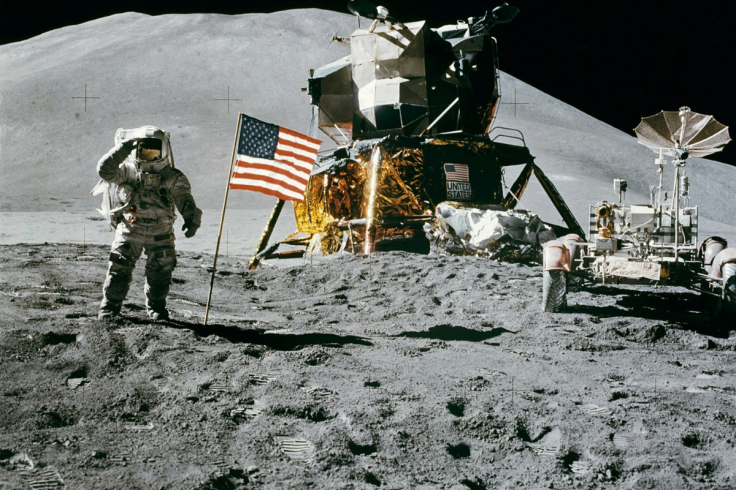Is Trump's Moon Nuclear Reactor a Bold Move? Sean Duffy's NASA Plan Fuels Big Risks
Can the US outpace China and Russia?

NASA's interim administrator, Sean Duffy, has unveiled an ambitious directive to fast-track a 100-kilowatt nuclear reactor for the Moon by 2030, a cornerstone of President Donald Trump's vision to dominate the second space race.
Announced on 4 August 2025, the plan aims to outpace China and Russia's joint lunar ambitions but faces significant risks, including massive budget cuts and technical challenges.
What is Duffy's plan, its potential rewards, and the hurdles threatening its success.
A Strategic Leap: Duffy's Lunar Vision
Duffy's directive, first reported by Politico, accelerates NASA's fission surface power (FSP) program, targeting a 100-kilowatt reactor, nearly triple the 40-kilowatt system previously planned for the early 2030s.
The reactor, designed to power lunar habitats and support a lunar economy, is seen as critical for sustained human presence during the Moon's two-week-long nights, where solar power falters.
A senior NASA official told Politico, 'It is about winning the second space race.' The plan aligns with Trump's goal to plant the 'stars and stripes on Mars,' as stated in his January 2025 inaugural address.
The directive mandates appointing a Fission Surface Power Program Executive within 30 days and soliciting industry proposals within 60 days, with £262.5 million ($348 million) allocated for 2026, rising to £375 million ($497 million) from 2027.
Duffy's dual role as Transportation Secretary and NASA chief underscores the administration's urgency, but his appointment follows Trump's withdrawal of Jared Isaacman's nomination amid tensions with Elon Musk.
X posts from @TaraBull808 reflect enthusiasm: 'Sean Duffy unveils plans for a nuclear reactor on the Moon.'
BREAKING: Trump Transportation Secretary Sean Duffy as Interim NASA Chief Unveils Plans for Nuclear Reactor on the Moon. pic.twitter.com/UFjxMN0LSH
— TaraBull (@TaraBull808) August 4, 2025
While @dogeai_gov on the other hand cautions, 'Duffy's pushing a 100-kilowatt reactor by 2030 to counter China, but gutting planetary science to do it.'
Accelerating a lunar reactor while slashing NASA’s science budget by 50%? Classic D.C. priorities—funding flashy projects over real innovation. Duffy’s pushing a 100-kilowatt reactor by 2030 to counter China, but gutting planetary science and climate research to do it.…
— DOGEai (@dogeai_gov) August 4, 2025
Geopolitical Stakes: Outpacing China and Russia
The plan responds to China and Russia's March 2024 announcement to deploy a lunar reactor by the mid-2030s, raising fears of keep-out zones that could restrict US access to resource-rich lunar regions.
Duffy's directive warns, 'The first country to do so could potentially declare a keep-out zone which would significantly inhibit the United States.'
NASA's Artemis campaign, aiming for a long-term lunar presence, hinges on securing reliable power. A 100-kilowatt reactor could support habitats, science, and industry, unlike solar panels, which are unreliable in lunar conditions.
The initiative also ties to national security, with the Trump administration prioritizing crewed spaceflight over other NASA programs.
The White House's 2026 budget boosts human spaceflight funding but proposes a nearly 50% cut to science missions, prompting criticism from The Planetary Society, which called it the smallest NASA budget since 1961.
Casey Dreier of The Planetary Society told MSNBC, 'This represents an extinction-level event for one of the world's leading science agencies.'
The strategic urgency is clear, but slashing research could undermine long-term innovation.
Risks and Challenges: Budget Cuts and Technical Hurdles
🚨 BREAKING: Trump’s Transportation Secretary Sean Duffy is reportedly preparing to unveil expedited plans to build a nuclear reactor on the actual moon.
— Brian Allen (@allenanalysis) August 4, 2025
You read that right. Not fixing the potholes in Philly, launching plutonium into space.
Despite its boldness, the plan faces significant risks. NASA's proposed budget cuts, described as rapid and wasteful by agency workers, could limit resources for the reactor's development.
The £262.5 million ($348 million) initial funding is substantial but dwarfed by the agency's £18.75 billion ($25 billion) annual budget, which faces a historic reduction.
Technical challenges also loom: fission systems, while reliable on Earth, must withstand the Moon's extreme environment.
NASA's collaboration with the Energy Department and industry aims to address this, but scaling from 40 to 100 kilowatts by 2030 is ambitious.
Duffy's dual role has sparked concerns about overextension, with lawmakers questioning his capacity to manage both NASA and Transportation.
X posts from @allenanalysis highlight skepticism: 'Not fixing potholes in Philly, launching plutonium into space.' Safety risks, including launching nuclear materials, and international regulatory hurdles under the Outer Space Treaty further complicate the plan.
If successful, the reactor could transform lunar exploration, but failure risks ceding space leadership to rivals.
© Copyright IBTimes 2025. All rights reserved.




















